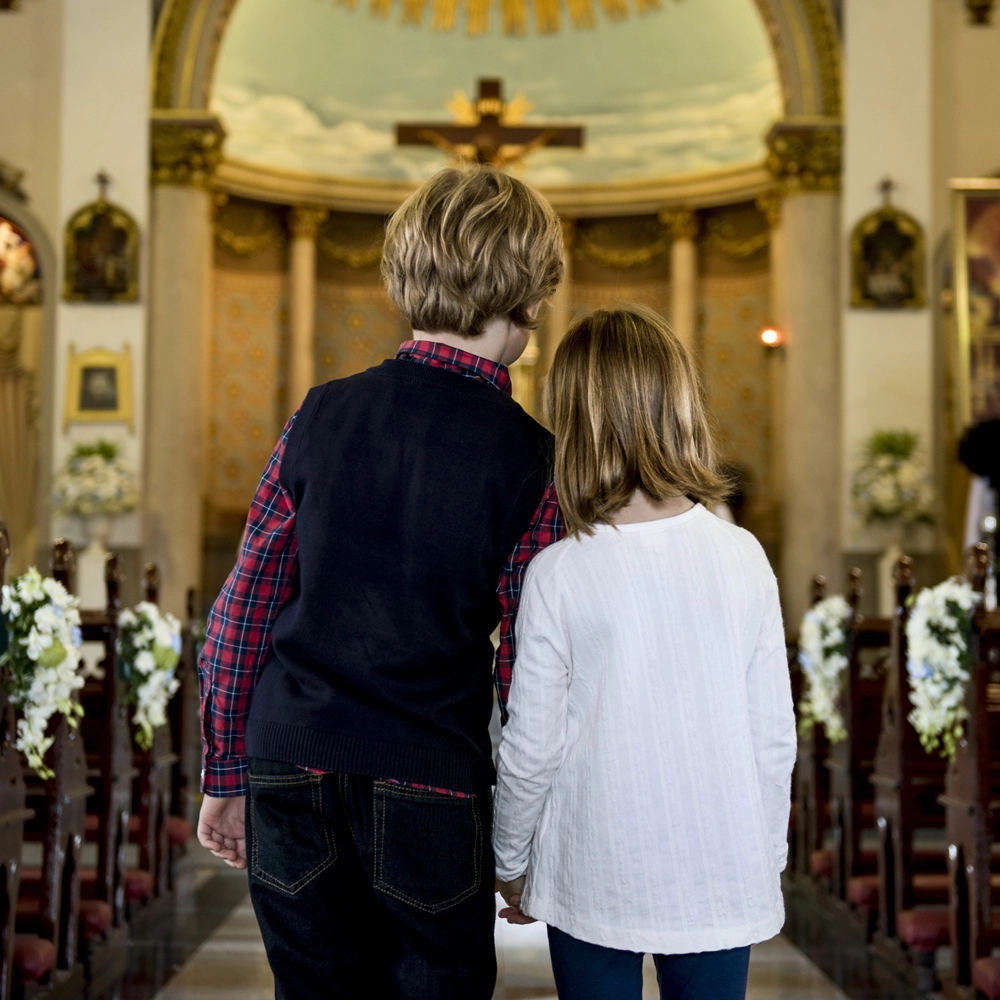Places of worship are frequently solemn environments for adults to gather, and contemplate / celebrate their relationships with the Almighty. Worship services are established with the adult believer in mind, and great effort is made to bring glory to God in each service ritual. Sometimes in our attempts to glorify God and bear witness to adult worshipers, the greatest of church resources are overlooked. Witnessing to young families with small children is vitally important to churches, and providing a Godly experience -from birth to young adulthood- is at the core of many family values.
Sadly, young families experience high levels of stress and anxiety while trying to attend church services, modeling what it means to be faithful to the most impressionable congregates…our children. The unfair expectation placed upon parents with children who are too young to attend formation, threatens the devotion of the faithful. For the survival of our places of worship, and for the spiritual health of the devoted, below are ways parents and churches can survive this trip in lifespan development.
Allow for Movement and Exploration
Children are naturally active, energetic, and incredibly curious. Homes have toys, play areas, jungle-gyms, and elaborate set-ups that allow children to explore their own boundaries with movement. Very seldom does child’s play involve stillness. Moreover, a child’s lack of movement at this developmental stage would signal concern in experts. Knowing that children need motion, it begs the question, why would we expect an hour of stillness? In fact, children who need rapid changes of scenery can be looked upon as highly intelligent. Intelligent children often rapidly process the environment surrounding them, and then are ready to absorb new information provided by a change of venue. In fact, the faster your child becomes restless or bored could be an indication of intelligence by how quickly they process the visual stimuli around them. This is not a demonstration of a child that cannot behave. This is a demonstration of curiosity, and a rapidly processing toddler.
What Parents Can Do: Consider leaving your seat in the church to walk around the perimeter, allowing your child to fully absorb and explore the prayer space. Enjoy the art that hangs, statues, relics, or stained glass with fun shapes and colors. Every inch of space explored will keep children engaged. Develop the understanding and maintain the frame of mind that you are introducing your child to the wonders of spirituality, and you are providing them with a sense of ownership inside of their worship space.
Know that Crying is Expressing
Children who do not have words express themselves through sounds, and non-verbal cues like facial expressions. Our inclination is to remove or silence our babies when their cries, or joyful screams, echo throughout sanctuary space. It can be even more mortifying if our babies hear their echo, and then happily exercise their vocal abilities! And then there are the frustrated cries of toddlers who have absorbed all that they can in the space they are in. Like movement, toddlers and babies are supposed to make noise. If a two-year-old attends an adult service, not making a sound, sitting idly while an adult message is delivered, this may demonstrate a deviation to developmental norms. Like activity, sounds are normal for healthy developing little humans.
What Parents Can Do: Keep a mantra prepared when you feel like all of the church is looking at -and judging- you when your toddler sounds off in the middle of a sacred prayer. “This is normal AND healthy for my developing child,” could be cognitively recited to drown out the negative thoughts. Further, remind yourself that you hold in your arms the future of your church community. That joyful scream or exhausted cry is the sound of hope and vitality for your community. Redirection is a great way to win back a frustrated toddler who is exercising their rights to express their feelings on the matter. Visiting an area where they can be boisterous, and returning to your seat during songs is a great strategy as well. Lastly, remember that the majority of the established members of the church have been where you are. You are not the first person whose child sang out at an inopportune moment. God willing you also will not be the last either.
Change the Lens… This is YOUR Future and Survival
Looking around at Sunday you may notice that in ten years that same service would look drastically different. This is especially true if we made our youngest members feel any other way than loved and accepted exactly as they are. Church populations have decreased with each generation. Many people report being faithful but not religious. Churches are even seeing fewer marriages today as compared to twenty and thirty years ago.
There are many initiatives in churches that focus on the family. Creating a psychologically protective space for worshipers with children ensures that, at a minimum, we do not reject our future when they do what comes natural during human development. Changing the lens from which we view an “unruly” toddler is essential for a struggling parent. In that moment we should control our non-verbal response from one of scorn for the disruption, to one of appreciation and hope, and provide normalization that the struggle for parents is real. Provide struggling parents with empathy and the compassion of Christ, by recalling the time that you were a parent of a toddler or baby that sang out of turn -and tune-. Provide disclosure of that memory for the parent who appears forlorn or embarrassed so that they do not feel alone.
Supporting parents with empathy, disclosure, normalization, and controlling our non-verbal responses to show love and patience, are all ways of encouraging parents with young children to attend and remain active members of church communities. This sense of belonging is essential to the survival of our communities, and raising young disciples who will one day take our places in the pews as the faithful.



